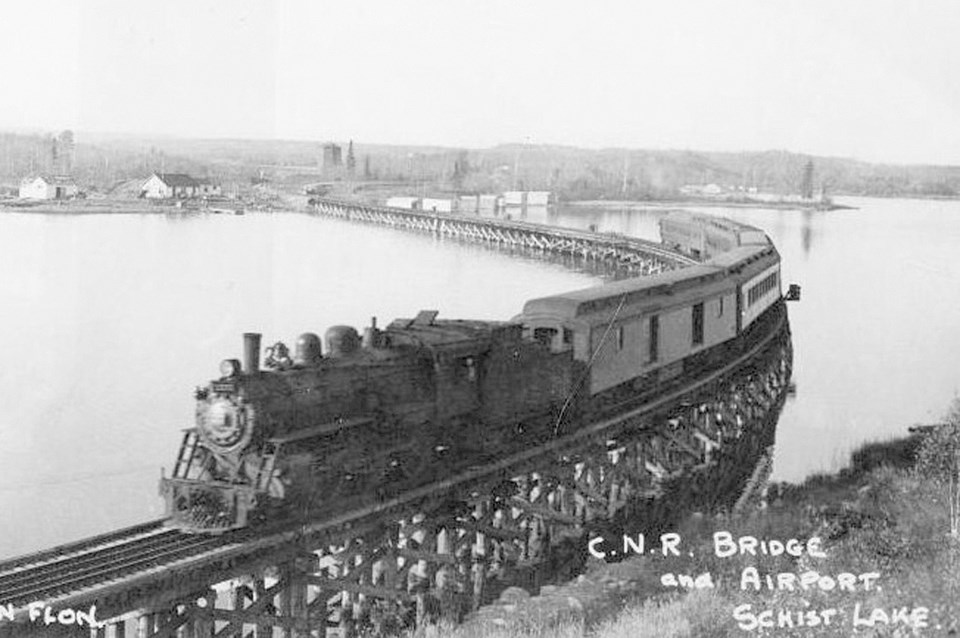The Canadian National Railways passenger train had just left the Channing station - yes, there once was a station in Channing - and was proceeding over the Schist Lake bridge. It was 1946. I was six years old, and hiding under the seat. Why? Well, looking out the day coach window I couldn’t see the bridge and I was terrified that the train would tip over and fall into the lake. My mother laughed and eventually convinced me to come out of my hiding place once we reached the end of the bridge.
Thus I begin my recollections of the marvel of train travel dating from the early ‘40s to the present where I have ‘rode the rails’ across Canada, in Ireland, England, the Chunnel train to Paris and the AMTRAK from New York to Washington, D.C.
The Flin Flon mine and town sites, once the rocks were scratched clear of the overburden, were totally dependent on rail service. In the beginning, materials, supplies and people were freighted over the water and ice routes from The Pas via Sturgeon Landing, Camp II and the Athapapuskow water route. But it was when the rail line from Cranberry Portage was completed in 1928 that one of the world’s largest mining developments of the time would raise its framework to the northern sky.
And the people. Men – and few women — made their way to jobs that didn’t exist in other parts of Canada during the Great Depression. Imagine yourself growing up on a farm in the south or arriving from a European country without English language skills. Imagine getting on a train in the south and rattling along the rail line and into the bush country. From Hudson Bay Junction on it was just bush. And in the early days, as a means of controlling who got in, you had to have a job permit in order to board the train at Cranberry. Yes, the freight trains built the mine but it was the passenger trains that brought life to the mine.
My train adventures began when my mother packed a couple of suitcases and loaded them along with my brother and I onto the Canadian National passenger train that left for Regina. What excitement! We were going to the farm – our Uncle Albert’s farm just outside Regina.
The Regina train #6200 left Flin Flon Monday, Wednesday and Friday at 8:00 pm and arrived in Regina at 2:30 pm the next day. Travellers to Winnipeg would depart at 4:30 pm Tuesday, Thursday and Saturday. There were connections at The Pas, Hudson Bay Junction and Melville for east or west bound traffic.
The departure and arrival of the train was a busy scene what with the activity of moving freight and baggage, passengers coming and going, family and friends to meet and bid farewell – along with those who just enjoyed seeing the train come and go.
Track space at the uptown station was limited. Thus, the arriving train would unload and then back down to turn around at the ‘Y’ near Birchview and then proceed engine first to the Channing yards where the engine and cars would be serviced for the next day’s run. It would then back up to the station to load for the next run south.
The train included a steam engine, tender, a baggage car or two, two day coaches, a dining car and a sleeper. Being on a budget we travelled day coach occupying a double seat.
The conductor was the boss of the train and he would walk the cars, at first collecting tickets and then announcing the upcoming stations. The ‘newsy’ was another prominent member of the train crew as he wandered from car to car renting pillows then offering magazines, candies and other treats for sale. He also sold what my mother referred to as ‘CNR sandwiches’ – the ham so thin that, as she would say, you could use it as newsprint paper.
The train had a rhythm in those days before continuous welded rail sections. The wheels would clickety-clack through the dark of night. A soothing sound that would soon send us off to dreamland.
Early morning would bring the end of the bush and a view of green fielded open spaces as we departed Hudson Bay Junction. My mother had grown up on the prairies and to her this was a blessed sight. To her embarrassment though, she winced at my comment that, “Gee, these people down here sure have big lawns!” Hey, I was a boy from the bush and the prairie view was new to me!
We’ll continue our train travel adventures next month.
Vincent Murphy-Dodds is a former Flin Flon resident now living in Regina. His column appears the first Wednesday of the month. Comments on his column are welcome. Contact [email protected].




